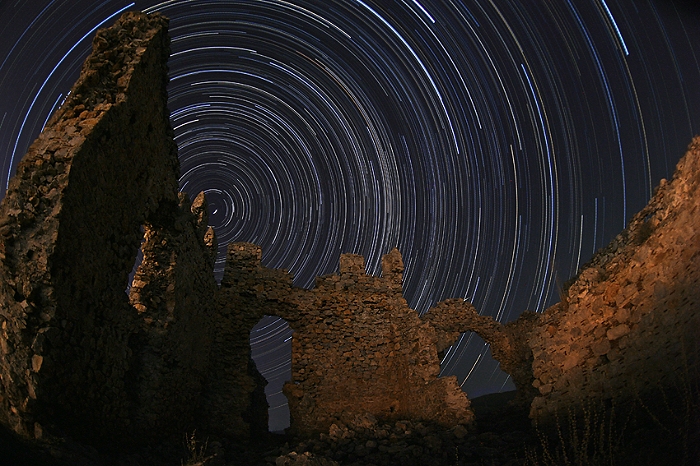
One of the most basic types of astrophotography and yet equally stunning is that involving star trails, particularly
around the celestial poles or immediately due east or west. In addition to capturing the motion of stars around the
north pole which are circumpolar and, hence, never rise or set, we also have the ability to capture seasonal
constellations and stars in such photos, thus allowing for different opportunities during different seasons. Star trail
photos also provide direct evidence that our planet rotates and does so at a rate of 15° per hour. Furthermore, by
studying the arc for a particular star, especially as far away from the pole as possible, one can indirectly estimate
the length of the (total) exposure which often ranges from seven to eight hours in duration and is totally dependent
on the end of astronomical twilight one evening and its onset
the following morning.
Many star photos are centered on Polaris, a double star system which represents our quickest means to locating the
north celestial pole, for it lies less than 1.0° from it, and is an excellent starting point for the polar alignment
of a telescope (and finding your way home if you are lost!). Due to the extended length of the typical exposures
involved, the best film for such work is Kodak Elite Chrome (ISO 100) whose reciprocity failure is nearly zero or
Fujichrome Velvia and Provia (ISO 50 and 100) emulsions with equally impressive curves! With respect to equipment, it
is rudimentary, for a camera with extended exposure capability is required along with a firm tripod and shutter
release and locking cable. It is also preferable that the camera used have a mechanical shutter so that battery
consumption and power does not become an issue during mid-exposure. The final requirement is a location with dark
skies - the darker the better so that the trails and their colouration will be as bright and contrasty as possible -
with, preferably, an interesting foreground which can be used to enrich the final result.
Note: One of the many castles which characterize Greece's second largest island, Euvoia, is
the medieval Castle Fyllon (Κάστρο Φύλλων) lying atop a hill 160 meters above ground level and to the east of the small
town Fyllon which sits at the base of the same hill. Also known as Castle Kastelli and Castle Likario, the castle was
built by the Venetians in the 13th century AD and is widely associated with the Venetian knight Licario who sought and
virtually managed to conquer all of Euvoia on behalf of Michael VIII Palaiologos (1223-1282), Byzantine Emperor of the
time (1259-1282), as vindication against the family Carceri who lived on the central portion of the island and who
despised him for secretly marrying their daughter. Following the completion of his final military campaign in Euvoia
and upon his consequent return from Constantinople, he ultimately chose the castle lying atop the 160-meter tall hill
Fyllon as his home and where he remained until the end of his life. His death is shrouded with some mystery and, according
to legend, he was poisoned by his beautiful lover from Chalkida, Euvoia. When the island of Euvoia was later invaded
by the Ottomans, two of the walls of Castle Fyllon were purposely destroyed so as to render the castle useless. It has
remained in this form to this day with the northern and eastern sides totally obliterated.
|
Proper Star Name: Polaris Bayer Letter: α Ursae Minoris Tycho Catalog: TYC 4628-237-1 SAO Catalog: SAO 308 Luminosity 2290 +/- 282 x Sun Distance: 431 +/- 26 light yrs RA / Dec: 02h 39m 31s / +89° 17' 39" B-V Color Index: +0.570 mag Magnitude: 1.98 |
 |
Date: July 20-21, 2014 22:14 - 02:42 UT+3 Location: Fylla, Euvoia, Greece Equipment: Canon EOS 5D Mk I Zenitar MC 16mm / f2.8 @ f4.0 Exposure(s): 266 min (133 x 120 sec) (RGB) 014 min (007 x 120 sec) (Dark) ISO 400 JPG Fine Image Format 4368x2912 Image Size Continuous Servo Mode Software: Startrails V1.1 Photoshop CS5 Processing: Dark Frame Reduction Layers and Lighten Resampling Unsharp Masking JPG Compression |